Definition: In experimental designs, jitters refer to the introduction of (pseudo-) random variations in the timing between successive stimulus onsets. They are implemented to mitigate potential confounds (e.g., habituation effects), avoid inducing rhythmic or predictive brain responses that are time-locked to the periodic onset of stimuli, and assist in deconvolving the hemodynamic response by introducing stimulus timing variability. Moreover, jitters are introduced to minimize temporal autocorrelation and enhance statistical power. That is, they serve to reduce correlation between successive stimulus onsets, mitigating any potential bias caused by temporal dependencies. By introducing (pseudo-) random variability in the timing of stimuli, jitters can help to improve the reliability and robustness of statistical analyses.
Alternative definition: (if applicable)
Synonym:
References: https://doi.org/10.1162/jocn.2008.20007
Related terms: Stimulus Onset Asynchrony (SOA), Inter-stimulus interval (ISI), Inter-trial interval (ITI)
